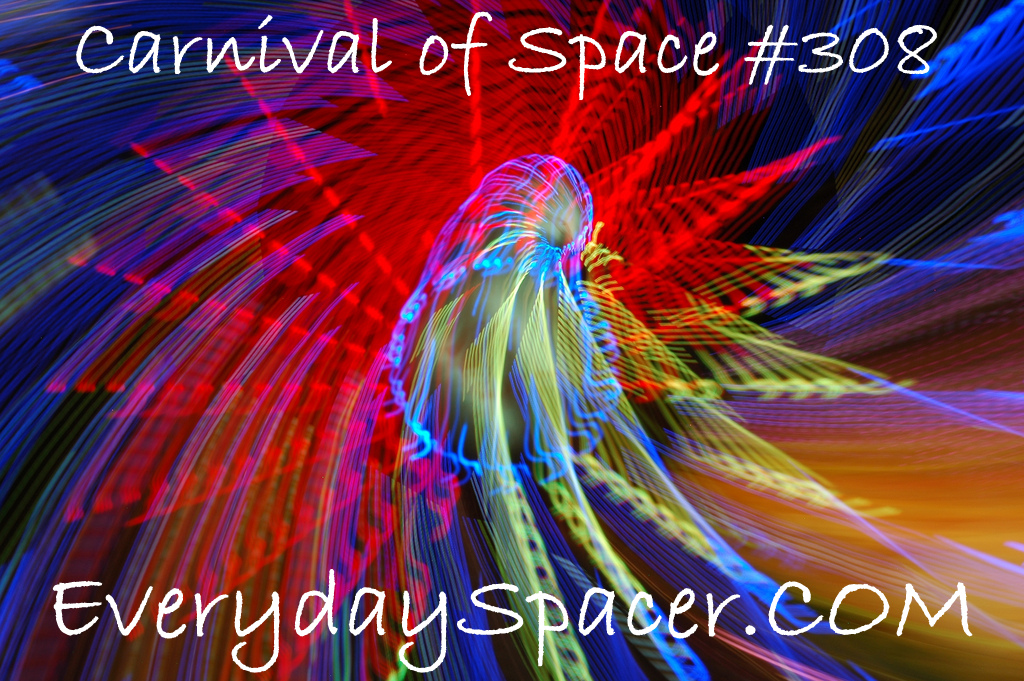 Welcome to Carnival of Space #308!
Welcome to Carnival of Space #308!
Every week, a different blogger hosts a variety of articles submitted by other ‘carnival’ members to bring you a symphony of voices in the spacer blogosphere.
EverydaySpacer.com is the host this week.
For the history buffs, we learned about the source of CoS from Steve Nerlich’s Carnival recently:
“The Carnival of Space was created in 2007 by Henry Cate of the Homeschooling Blog and who then gave it to Fraser Cain of Universe Today and now it is continued by Brian Wang of Next Big Future. If you’d like to be a host for the carnival—or contribute to it, why not send Brian an email at blwang at gmail.com.”
We’re starting off with…
The Moon’s Antipodal Magnetism Mystery
M3D
Dr Paul Spudis writes on “The Moon’s Antipodal Magnetism Mystery”
Magnetar Near Black Hole to Provide Another Test for General Relativity
Allen Versfeld | Urban Astronomer
While waiting for a gas cloud to fall into the Supermassive Black Hole at the centre of our galaxy, astronomers found a magnetar which will let us test General Relativity even more strenuously
Earth’s Nightlight
Paul D. Spudis | The Once and Future Moon
Syzygy (alignment) is not the same as perigee (the closest approach of Moon to Earth) but on the occasion when syzygy and perigee coincide, we have what’s called a “Super Moon.”
The Remarkable Remains of a Recent Supernova
Megan Watzke | Chandra X-Ray Observatory
G1.9+0.3: The Remarkable Remains of a Recent Supernova
Planetary Resources Partners with 3D Systems
Brian Wang | Next Big Future
3D Systems and Planetary Resources announced today that 3D Systems has joined Planetary Resources’ core group of investors and will be a collaborative partner in assisting Planetary Resources to develop and manufacture components of its ARKYD Series of spacecraft using its advanced 3D printing and digital manufacturing solutions.
A Nearby Faint Star With 6 or 7 Planets
Andrew Fraknoi | Exploring the Universe
On the discovery of 6 or 7 planets around the nearby faint star Gliese 667c, at least three of which are in the star’s habitable zone. Discusses the implications of the discovery for the search for planets and life.
Multiverse Evidence from Higgs Boson Details
Brian Wang | Next Big Future
Lack of other particles around the Higgs Boson suggests that there is a multiverse to explain the tuned parameters
Evidence of Collision with Another Universe During the Early Formation of Our Universe
Brian Wang | Next Big Future
The different temperatures in the cosmic background radiation could also be explained by a multiverse collision. Or it could be a competing theory or a less that one in one hundred fluke of quantum fluctations in the early universe
Three ‘Super-Earth’ Planets Discovered Orbiting in Habitable Zone of Nearby Star
Paul Scott Anderson | The Meridiani Journal
There is some exciting news today regarding exoplanets – for the first time, multiple planets have been found orbiting within the habitable zone of their star, the region where temperatures can allow liquid water to exist on planets with rocky surfaces, like Earth. The news release was published this morning by the European Southern Observatory (ESO).
The Astronaut View of Colorado Fires
C.C. Petersen | The Spacewriter’s Ramblings
TheSpacewriter shows the astronaut’s view of the Colorado fires.
Further Evidence of 600-1000 km/s Flow Across 2.5 Billion Light Years Which Might Mean an Attraction from Another Universe
Brian Wang | Next Big Future
There is a 600-1000 kilometer per second flow of stars across 2.5 billion light years and that flow could be shown to be even be larger with more measurements. This suggests that there is another universe beside ours generating a massive gravitational attraction.
Talking about the ISS to the Australian Air League
Ian Musgrave | Astroblog
On Friday night I gave a talk to the SA branch of the Australian Air League. The Air League is a bit like Scouts, only with an aviation/avionic theme. They have their 80th anniversary coming up, and have applied to speak to the astronauts of the International Space Station.
Three Exoplanets in a Habitable Zone? The Gliese 667 C System in Celestia
Ian Musgrave | Astroblog
Our search for extrasolar planets keeps turning up science-fiction worlds! The latest is a planetery system around one star in a triple star system that hosts not one, but three planets in its habitable zone (c, f [illustrated above] and e).
We’ll update this post until CoS #309! Stop by later in the week.
Original image source: http://www.flickr.com/photos/looking_to_the_east/6085855884/in/photostream/






































Pingback: Carnival of Space 308 – Multiverse evidence and exoplanets
Pingback: Space-for-All at HobbySpace » Carnival of Space #308 – Everyday Spacer
Pingback: Carnivalia — 6/27 – 7/02 | Sorting out Science